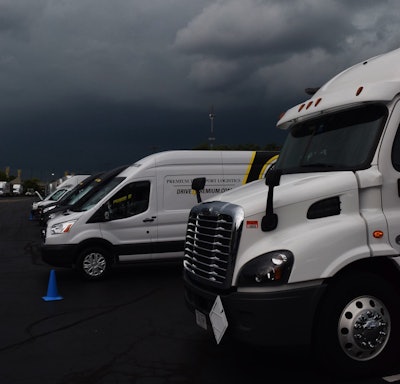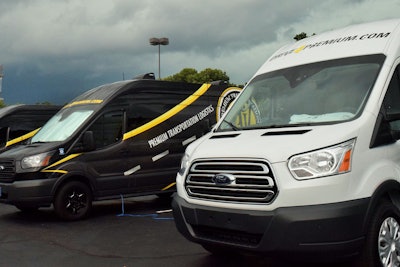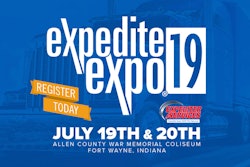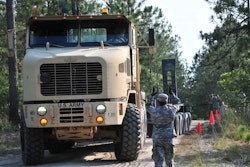 Mid-afternoon view on the truck lot at the Expedite Expo Friday, July 20, as a big storm rolled in.
Mid-afternoon view on the truck lot at the Expedite Expo Friday, July 20, as a big storm rolled in.Counterintuitive to the views of many in Overdrive‘s audience, John Elliott, CEO of the Load One 435-power-unit expediting carrier, believes that mandated electronic logging devices might be one of the best things to ever happen to trucking. And it’s not all about capacity stress and rates growth. His reasoning follows the changes he’s seen at his own carrier, as well as others, as it relates to true back-office support of operators on the road.
In fact, the ELD mandate could be the “best damn thing that ever happened to drivers,” specifically, he said as part of a panel at Expedite Expo this past weekend.
He laid out a prototypical dispatch scenario he says he’s seen firsthand plenty of times — when he worked in dispatch himself, he was “guilty of it,” he says. It’s one that the ELD mandate has helped mitigate.
Presented with a load for a driver without enough, or with just barely enough, available hours to complete it on-time, the dispatcher says simply, “Can you make this load work?” What he means: it may require a bit of creative log writing to get it done.
The driver: “Of course, I’ll make that work.”
“That’s gone,” Elliott says. E-logs, to which Load One transitioned four years ago to get ahead of the curve, have “forced carrier operations and customers to help deal with” scheduling pressures drivers face.

He was speaking along with Women in Trucking founder Ellen Voie and Stu Sutton, creator of the Full Circle and, in the past, Sylectus transportation management systems, in the final-day “Future of Expediting” panel July 21. Moderated by Sean Lyden of Expedite Now magazine, the panel examined a variety of key areas aimed at casting a look into the near future for economic, regulatory and other issues germane to expediters — and truckers in general.
 From left: Stu Sutton, Ellen Voie, John Elliott and Sean Lyden
From left: Stu Sutton, Ellen Voie, John Elliott and Sean LydenAnother thing that’s impacted Elliott’s views on the ELD mandate is of a personal nature, of a fashion — “One of the worst things about being the owner of a company,” he said, is getting the late-night “call about the bad accident. My first question: What’s his log book like? You lived with that fear” that something would be out of line.
The move to the mandate, however, hasn’t been all fun and games for drivers and their motor carriers transitioning late in the period before the December 18, 2017, suggested Sutton, who postulated a 6-8 percent rate of attrition when it comes to drivers employed and the productivity rate of those who remained, depending on the carrier’s operations.
“We didn’t lose any drivers over it,” Elliott said, though operational adjustments were key during the early days of the fleet’s move to e-logs, as noted.
A bonus that everyone could get out of it in the end: Elliott said he believes the hours of service rule itself is going to improve for most drivers now that the heat is turned up on it, and regulators can truly see via data-sets from ELDs and real experiences that it can be “frustrating as hell at times. We’ve towed trucks in 15 miles from delivery to get them there” after the driver ran out of hours.
“Now we can actually take the ELD dataset and actually show [regulators] where and how it doesn’t make sense,” he added. “Now we can get past the ‘cheating’ thing and work on hours the way it’s supposed to work – to enhance safety. And I have plenty issues with it.”
Regulators aren’t the only parties getting an education in reality post-mandate, Sutton suggested, emphasizing many shippers are learning the hard way in higher transportation costs how inefficient their load/unload practices are. Regarding detention pay, he urged carriers to take their game up a notch. As an industry, trucking gives “an hour or two hours away for free. Who decided that? The industry should get together and say, ‘this is stupid. Don’t give away time for free.'”
Other topics discussed in the panel follow:
Economic conditions
 Moderator Lyden noted that the cargo van market, “especially in 2016, got hit hard.” Load One’s John Elliott noted that while rates for the company’s vans have generally improved since, “they’re a struggle – they are not super-profitable for a carrier, but for us to be full-service, we have to have them. They’re our lowest profit margin per vehicle,” but they also come with the lowest barriers to entry for drivers and carriers — no CDL, obviously lower cost for equipment and more. A fleet owner member of the audience noted she’d seen an influx of former truckload operators looking to haul in a cargo van to avoid the headaches of hours of service and ELDs in recent times. Elliott said he hadn’t seen that, and chided some van operators for leasing with multiple fleets and for fleets allowing it, resulting a situation where three carriers might bid down a single load for the same operator, driving down rates in a non-natural way. It’s an issue well-known among owner-operators in the segment.
Moderator Lyden noted that the cargo van market, “especially in 2016, got hit hard.” Load One’s John Elliott noted that while rates for the company’s vans have generally improved since, “they’re a struggle – they are not super-profitable for a carrier, but for us to be full-service, we have to have them. They’re our lowest profit margin per vehicle,” but they also come with the lowest barriers to entry for drivers and carriers — no CDL, obviously lower cost for equipment and more. A fleet owner member of the audience noted she’d seen an influx of former truckload operators looking to haul in a cargo van to avoid the headaches of hours of service and ELDs in recent times. Elliott said he hadn’t seen that, and chided some van operators for leasing with multiple fleets and for fleets allowing it, resulting a situation where three carriers might bid down a single load for the same operator, driving down rates in a non-natural way. It’s an issue well-known among owner-operators in the segment.The economy is in many ways “hitting on all cylinders” at the macro level, Sutton said, in response to a question about what truckers can expect in the coming months and looking farther out. “Demand for your services is going up [and] not slowing down for the next six months.”
Elliott, who noted Load One is having generally a record year, was more bullish when it comes to projecting favorable economic conditions. “I’m comfortable [saying we’ll] have 18 months of sustained growth,” he said. “If you look at demand for new vehicles, it’s through the roof.”
A downside there: “You’ll wait 6-10 months for a new truck order.” He cautioned fleets and owner-operators trading three-five years down the road: “Will the used market get flooded with equipment?”
That could be especially true for truck-tractors, in great demand at this moment. “That truck you think should be worth $80,000 could be now worth $60,000” with a flood of used trucks, Elliott said, “a risk” for buyers today. “Pay down extra while you can. There are many things in the global economy that could bring things to a screeching halt.”
The march of technology
Voie said she believed that more women becoming active in trucking was raising the bar for things like vehicle design with driver comfort in mind, business tools and more. “Women bring a higher level of professionalism, too, because they’re [speaking up to a greater degree and] demanding it. Same thing with the truck stops – the level of service at the truck stop. … It’s raising the standard for everybody.”
Part and parcel of that is new vehicle technologies from adaptive cruise to active braking and other stepping stones toward a more self-driving truck, many of which carriers are adopting in hopes of they’ll be a clear safety-assist to the operator.
Positive views on such technologies aren’t 100 percent shared, of course. Dry van operator/expediter and former owner Nancy Hudson, a finalist for the Expo’s Expediter of the Year award speaking with Overdrive the day before the panel, offered a counterpoint to rosy views of advanced driver assist systems widely available in new trucks. Such systems, she held, hold too much potential to divorce the operator from close connection to his or her machinery, leading to a false sense of security where the safety rubber meets the road.
To an extent, Voie addressed such a counterpoint herself, noting that too many companies in her view “are using the technology to cover up for people who shouldn’t be there.” At the same time, she added, emphasis on the technology mastery held by a next-generation fleet’s drivers could well give companies a leg up with the Millennial and future generations of truckers, from a recruitment and retention standpoint.
Elliott, however, pointed to his fleet’s adoption of active braking throughout its trucks, and clear efficacy in prevention. Such technology can react to keep the vehicle at a set distance from the vehicle ahead, and apply the brakes in an emergency situation, when a collision is imminent. While “not one of my drivers wants to come in and say, ‘John, did that thing really save my butt, I would have crushed that car,” he said, no vehicle in the fleet outfitted with the tech “has had a rear-end accident in over a year.”
Elliott also emphasized, speaking to the notion of a fully-autonomous, self-driving truck with any potential to truly displace driver employment, that he was “bearish” on that becoming a reality in the next couple of decades. “There will be so many things that that truck cannot do.”
Attitudes among the general public, too, are not likely to change fast when it comes to getting comfortable “with an 80,000-lb. semi next to me — with nobody in it. … Why is the railroad not autonomous? It could be, and it’s not.” While next-gen, self-driving technologies are “sexy and nifty,” Elliott added, and have “raised a lot of money on Wall Street and from venture capitalists and all that, it’s going to be a long time before it’s in my company.”
For small fleets, though, he offered a word of caution about delaying adoption of, or ignoring, clearly beneficial technologies. He predicted a likelihood of more consolidation around trucking as larger companies swallow up small fleets that can’t compete on the tech playing field.









